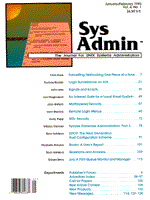
Sidebar: Using lprm
lprm has one purpose: to remove print jobs from the printing queue. If lprm is invoked without any arguments, the current print job on the default printer is removed from the print queue. Of course, users can only remove jobs that belong to them. If the current job doesn't belong to the user invoking lprm the queue remains unchanged. Users can specify a particular printer by using the "-P" argument. There are three methods for removing jobs from a printing queue. The first method specifies one or more job numbers, which are obtained through lpq, as arguments. This method is demonstrated here:
% lprm -Pprintername 235 236
In this example, print jobs 235 and 236 will be removed from the printing queue specified by "printername". The second method uses the "-" as an argument after the printer name. This method will dequeue all print jobs belonging to the person invoking the command. If this method is used by the superuser, all jobs will be dequeued regardless of ownership. The following is an example of this method:
%lprm -Pprintername -
The third method specifies a particular user name; it causes all print jobs belonging to the named user to be dequeued. Typically, only the superuser uses this method. It would be pointless for any other user try it, simply because their own user name would be the only legal argument available to them. The following is an example of this method:
%lprm -Pprintername rob
|